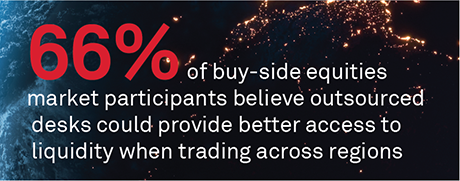
In 2019, Coalition Greenwich and Refinitiv, an LSEG business, embarked on a series of reports1 delving into the future of trading. These reports explored the profound changes sweeping across trading desks, the strategic leverage of big data and the evolving dynamics among trading professionals. The future of trading, once on a distant horizon, has now become an immediate, ever-evolving reality that is reshaping the equity markets in unprecedented ways. Traditional trading paradigms have been dismantled, replaced by a landscape where game-changing technologies like artificial intelligence and cloud computing have become commonplace.
Nonetheless, our assertion from 2019 remains true: “Five years into the future, financial services work will be a true merger of the best of both humans and machines. … Investing and trading decisions will still tilt toward human intuition, but data analysis and trade execution will more often see computer automation take the lead.”
As markets have become globally interconnected and increasingly complex, it is vital to underscore the significance of the human element, especially when trading globally, across geographical regions. While technology has revolutionized this process, the role of experienced and knowledgeable individuals remains irreplaceable in navigating today’s global markets.
In this report, we explore the challenges confronting the buy side as they trade global equities across regions, grappling with the demands of technological and operational efficiency. We explore the key attributes they seek in trading partners, and how a new breed of market participants is redefining the very essence of equity trading.
MethodologyCoalition Greenwich gathered responses from 45 buy-side equities market participants from June–August 2023. Of those, 58% were asset managers, 22% hedge funds, 11% family offices, and 9% mutual funds. Assets under management ranged from under $1 billion to $12 billion. Geographically, about half of study participants hailed from offices in the United States and half from Europe and the United Kingdom.

